Asian American Outlook. A Matter of Survival: Navigating Media During the COVID-19 Pandemic
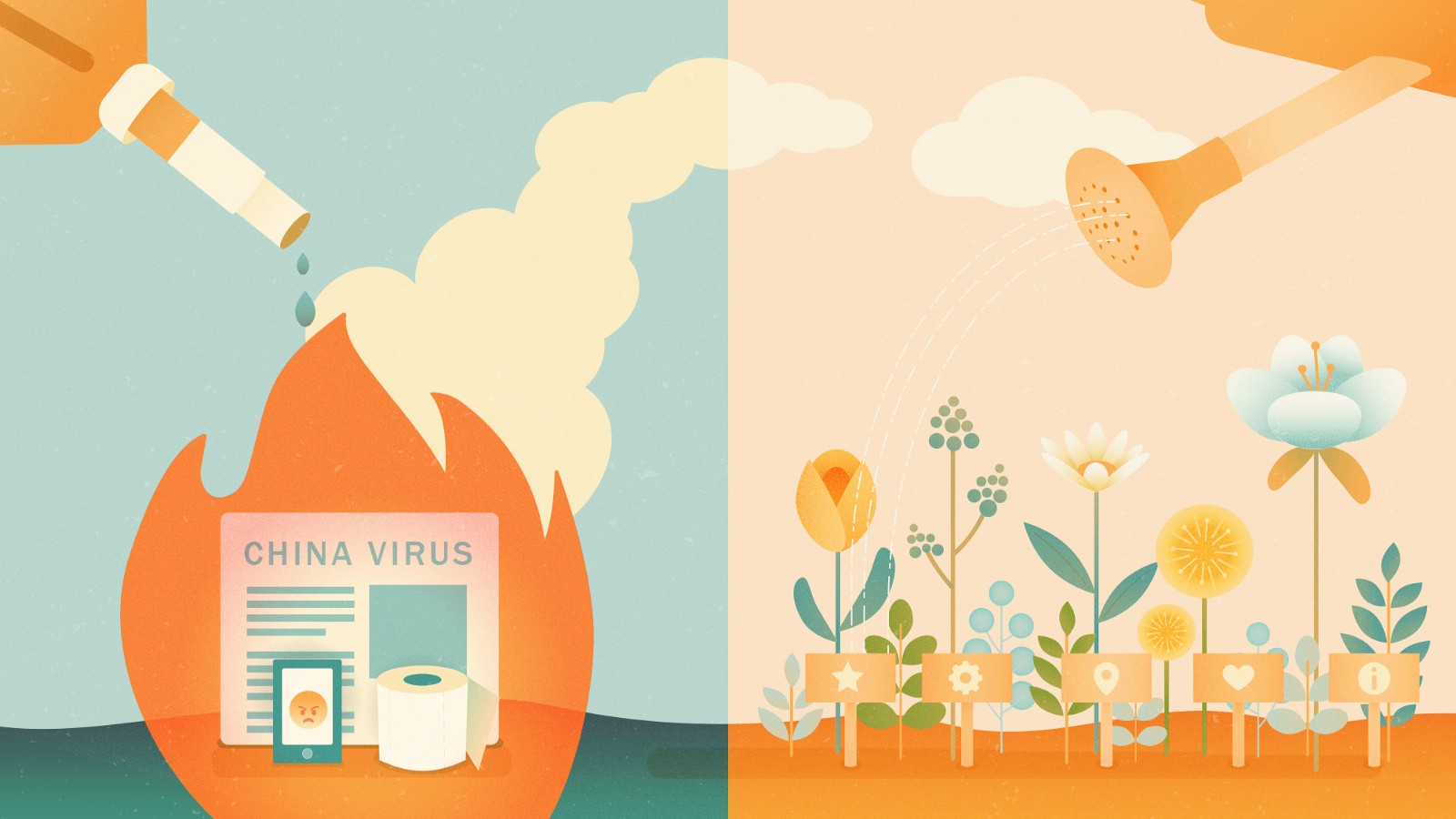
COVID-19 is a viral disease and a viral subject. It has dominated traditional news reporting, infiltrated all sectors of topical publishing, and is the main theme on social media.
More than any other pandemic, there is a fascination with and steady production of media coming live from the field; the impact this type of media dissemination has and the interest people have in it during a global health crisis is unmeasured.
Asian Americans have a unique place in this crisis, as a consumer group and how they consume media. Asians were more cautious and prepared when it came to COVID-19, having knowledge learned from past outbreaks, such as SARS, and being familiar from the start with the emerging situations in Wuhan, China and South Korea. The livelihood of this group is being challenged: with a high propensity for small business ownership, they have been dealing with strong financial concerns for months before the rest of the U.S. already; as immigrants with loved ones overseas, they are constantly consuming in-language information on the pandemic via multiple sources to stay up-to-date on evolving conditions around the world; and as members of strong communities with great cultural diversity, Asian Americans are collectively suffering intensifying racist attacks.
The critical role of the media can impact the cooperation of communities and systems to eradicate this virus globally. Media has the power to incite elevated consciousness and inspire collectivist movements, or to fuel fires of panic and cause division in society. Disseminated information is not purely neutral or up for interpretation - it can do the most good by being accurate, consistent, and culturally relevant, focused on promoting understanding and driving action. This is especially true in the Asian American communities, who subsist on multiple sources of news (in-country and U.S.) with varying levels of message consistency. The success of overcoming this unprecedented global crisis will be a testament to humanity's ability - governments, health agencies, municipalities, businesses, citizens, and media - to cooperate across all communities, including Asian Americans.
Intertrend Communications conducted a quantitative study to better understand the role of media and general sentiments among Asian Americans during the COVID-19 crisis. The survey sample size was 430–450 and was fielded across Chinese, Korean, and other Asian American segments during March 14–28, 2020. Intertrend also conducted social listening in parallel to the study to assess what topics people have been proactively searching for online. This reporting is based on data generated from Google Trends in the U.S. and in some of the Asian regions, and insights from analysis on Brand24.
Asian American Outlook
Asian Americans are a resilient group, as witnessed in their feelings of optimism during the 2008–2009 recession and quick recovery afterwards. Not only does this group possess the immigrant mentality of fighting through all adversity - political, economic, the process of starting over in the United States - they are also experienced in persevering through hardships specific to their minority group and relying on collective communities for support.
This group also has a penchant for saving and good financial management and, therefore, historically has been able to weather economic downturns. This is particularly crucial for Asian American communities now, as there is a doubly negative financial impact of COVID-19 on this population: the impact of lockdowns on spending in general and the impact of racial bias on Asian American businesses in particular. The resilience and preparedness of Asian Americans as a community is being tested.
The Intertrend survey shows that an overwhelming majority of Asian Americans, 78%, feel that COVID-19 will negatively affect their pocketbook, while 72% believe their businesses will be adversely affected and 69% believe that their investments will be hurt. Recent immigrants feel even more deeply about the negative impact of COVID-19 on their finances, by a factor of over 1.5 for believing their business will be affected, and by a factor of two for affecting their pocketbook.
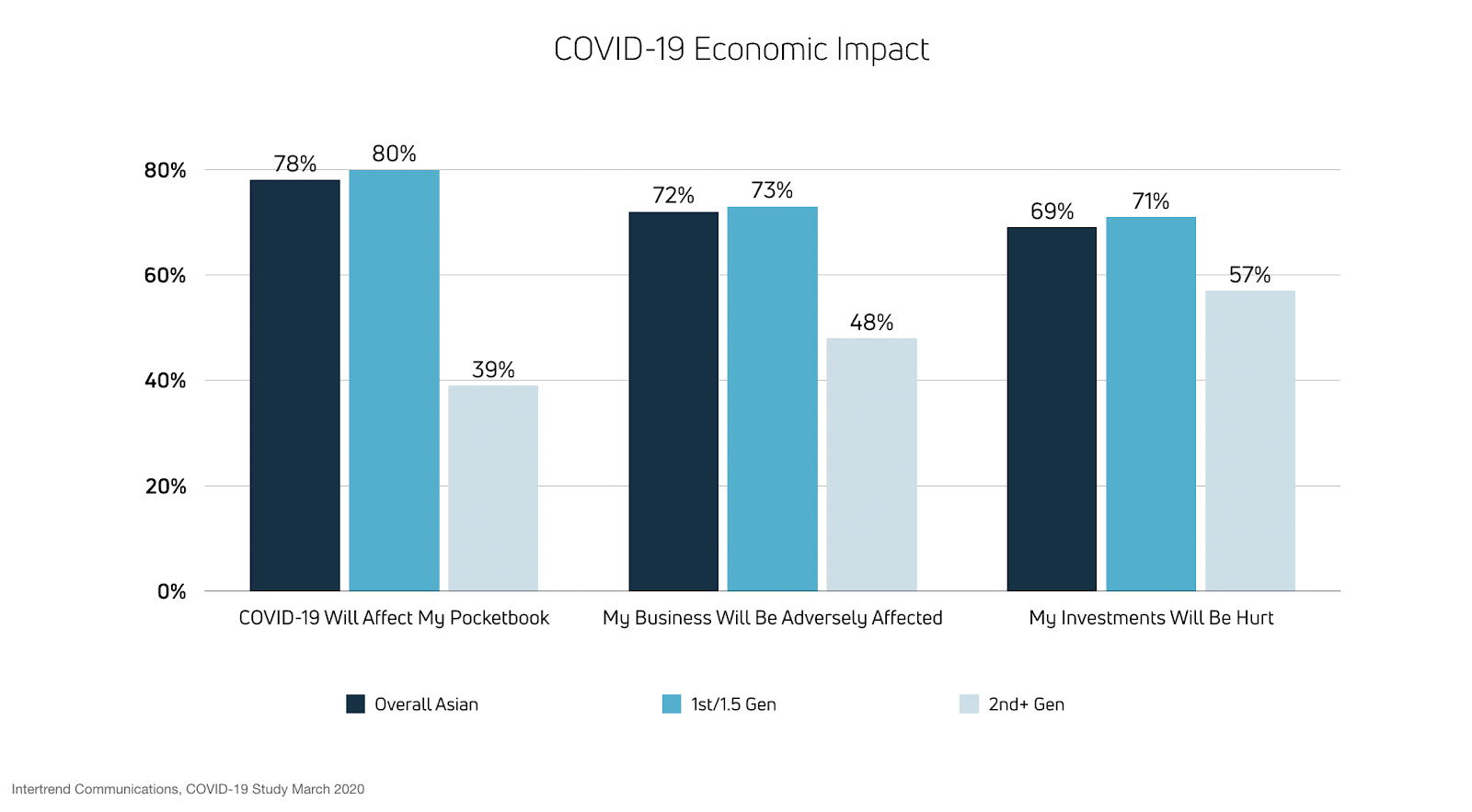
Analysis of sentiments by immigrant generation shows that the typical optimism of recent immigrants in the face of adversity is not present now due to their heightened anxiety regarding COVID-19. Since they were early in monitoring the global crisis due to the outbreaks in their home countries of China and South Korea beginning in January, they report more anxiety and fear than their first and second-generation Asian American counterparts. Overall, 79% of Asian Americans report thinking about COVID-19 frequently or very frequently and 60% are fearful of getting the virus. The first and 1.5-generations are thinking about it more frequently at 79% versus 57% of the 2+ generations (rating frequent or very frequent), and they are also more fearful of getting the virus, at 60% versus 43% of the 2+ generations.
Recent immigrants have had anxieties multiply over the past months, first worrying about the state of their home countries, then worrying about the situation in the country they are making their new home in. Asian Americans were among the most conscientious citizens early in the COVID-19 outbreak in the U.S., greatly over-indexing on avoiding social spaces and limiting non-essential travel compared to other consumer segments (Kantar COVID-19 Weekly Pulse 3/12–16) as well as overwhelmingly adopting the practice of wearing face masks, which is a social norm in Asia. Due to their desire to be socially responsible, Asian Americans themselves were avoiding eating at Asian restaurants or visiting Asian establishments, even while understanding the hugely detrimental financial impact that this would have on these businesses.
These intense fears and worries continue without relief, as 92% of Asian Americans believe COVID-19 is a serious problem and yet only 16% of Asian Americans believe that the U.S. is handling the crisis well. 35% of Asian Americans are unsure what the government is going to do and 24% do not understand the government health organization's explanations about the virus. Governmental changes need to be made to correct the imbalance between the strong feelings of the problem's seriousness and the lack of confidence in the solutions being presented.
In connection with feeling greater fears, recent immigrants are also more likely to think that the United States is not taking the COVID-19 situation seriously enough, with 70% of first and 1.5-generation Asian Americans feeling that the U.S. has underestimated this virus versus 65% of the 2+ generations. This immigrant generation sentiment differential is consistent when looking at how much Asian Americans fear traveling to work (58% overall), leaving the house (63%), and that a loved one may be killed by the virus (61%).
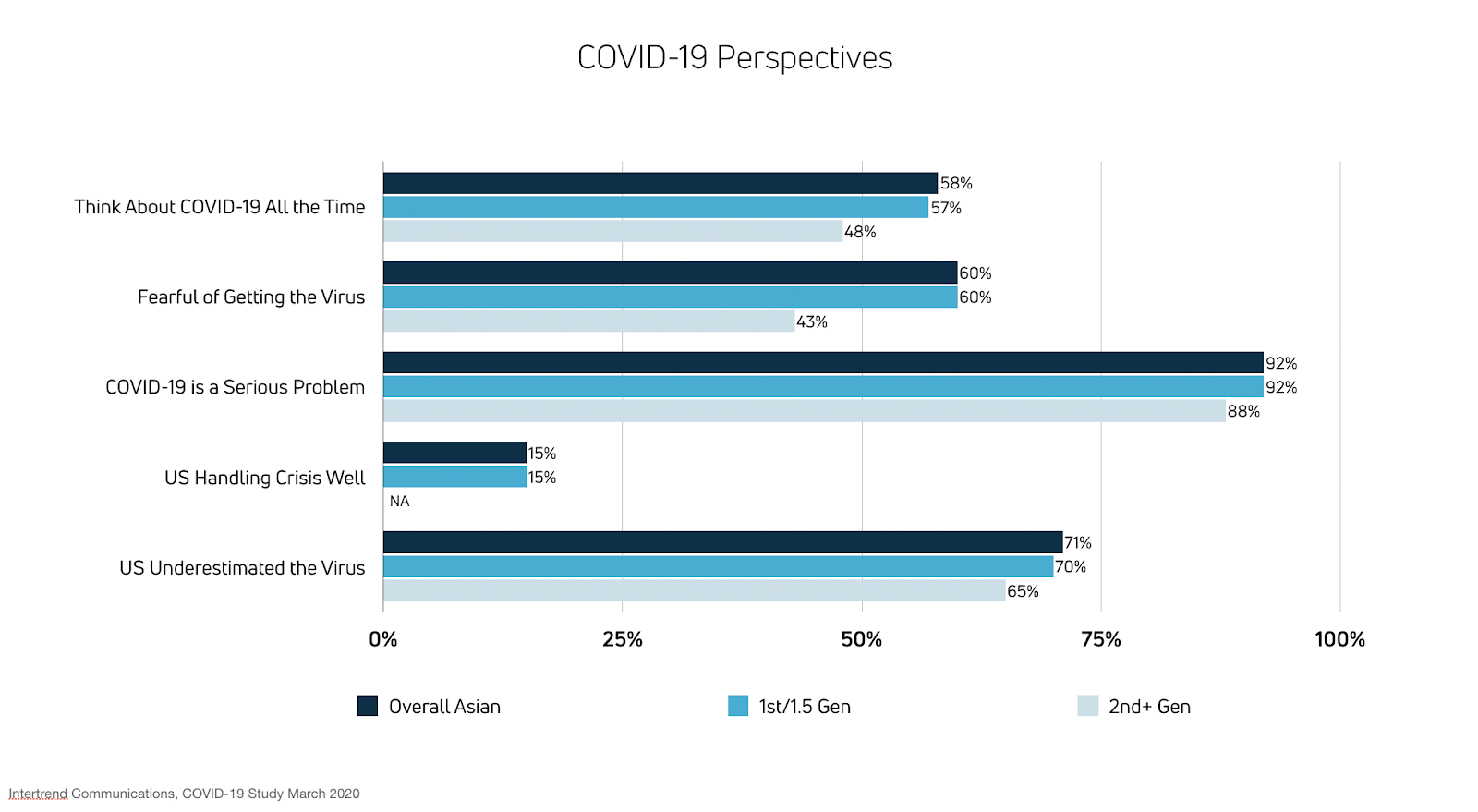
Asian Americans are bracing themselves for worse to come on many fronts. In light of how much of the Asian American community feels similarly, this is a time for heightened community awareness and support. Being able to weather the COVID-19 crisis financially, medically, and psychologically well will require concerted efforts in solidarity across generations and groups. Furthermore, improvements need to be made by the government in developing action plans, communicating those plans clearly, and disseminating information effectively to drive action.
News Processing Differs by Consumer Group

Despite complete media saturation on the subject of COVID-19, Asian Americans want to know more. While there is an abundance of news from many sources - in-country, individual governments, global and national health agencies, the local community, and social media - Asian Americans continue to want more reliable information specific to their needs. 43% of Asian Americans feel that there is insufficient information available about the virus. During the two weeks in which the Intertrend survey was conducted, the same time at which coastal cities were grappling with new stay-at-home orders, the top types of information searched for by respondents were: 1) knowledge on how the virus is spread, 2) community responses (lockdowns, restrictions, cancellations), and 3) symptoms and complications from COVID-19.
Within an intensive media diet on COVID-19 that ranges across a variety of Asian news sources such as - Korea Times, Korea Daily, World Journal, KBS TV, MBC TV, SBS TV, in-country YouTube, Kakao, and WeChat - Asian Americans consistently have more trust in news coming in their native language and from native language sources. 40% of Asian Americans trust in-language news more than English sources, 69% prefer in-language sources, and 42% prefer international sources, as found in responses on a five point scale that includes neutral sentiment.
The trust in and dependence on in-country and in-language media correlates to immigration waves, with 71% of first-generation immigrants preferring in-language media and 44% trusting the information supplied by in-language media on COVID-19 more, versus 51% of 1.5 generation Asian Americans relying on in-language media and 27% trusting it on COVID-19 more. Newer immigrants are more likely to agree that media coverage on COVID-19 is sufficient, versus second and third-generation immigrants. This is likely due to first and 1.5-generation immigrants following the COVID-19 news abroad more intensely early on.
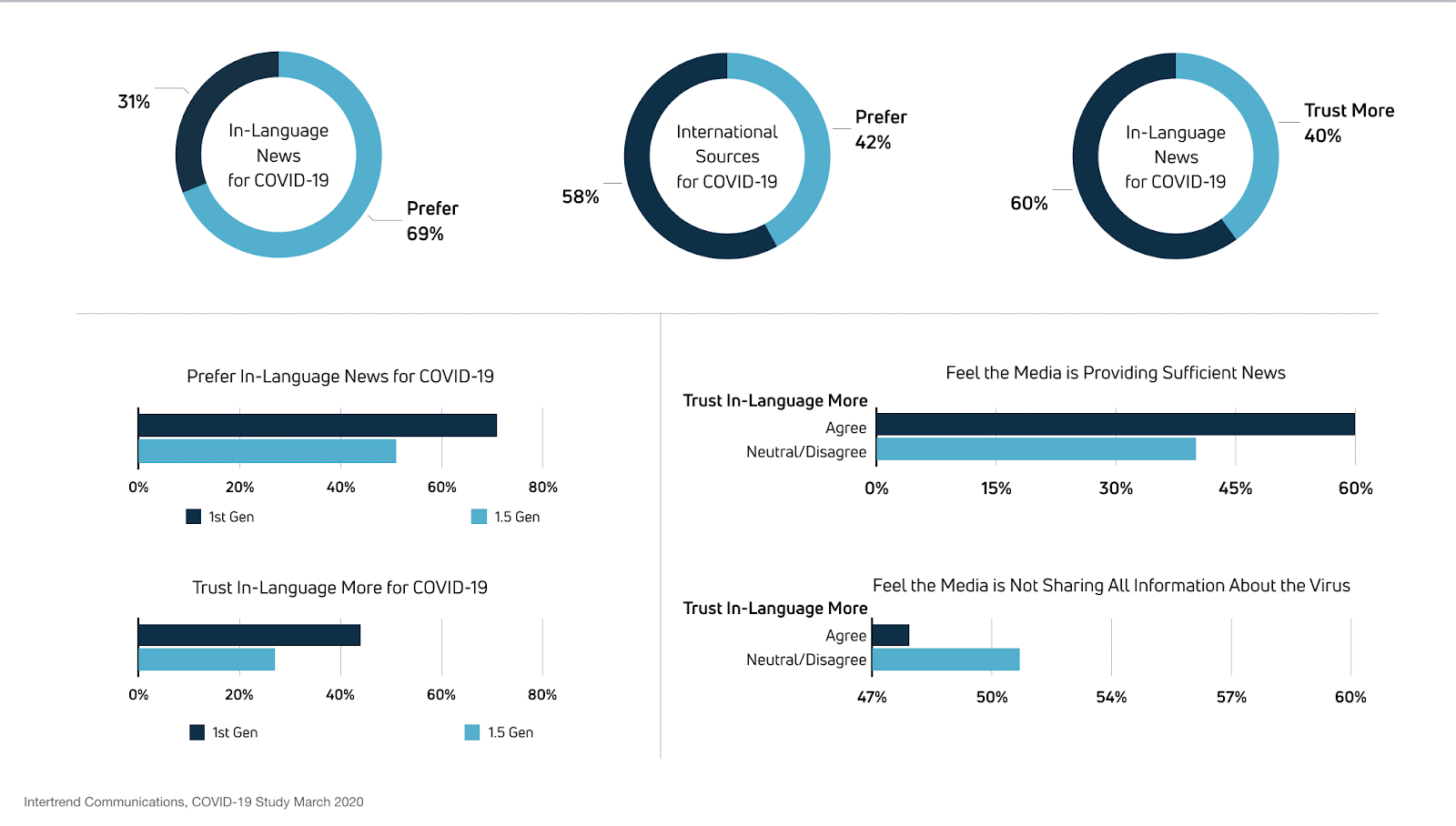
Asian Americans that consume in-language news also feel that the media is indeed providing a sufficient amount of information. 60% of Asian Americans who trust in-language media more feel that the media is providing sufficient news versus 43% of those who don't trust in-language media as much.
That doesn't mean Asian Americans trust the media whole-heartedly. Those that trust in-language media more are also skeptical of whether the media is being fully transparent, with 48% of that group believing that the media is withholding information about the virus versus 33% of the group that doesn't trust in-language media as much. It appears that Asian Americans who trust in-language media more see the in-language news as providing good, dependable coverage, and are ultimately even more knowledgeable than what the headlines reveal.
When it comes to social media and trending search topics, Chinese Americans started talking about the virus in late December, and the most popular posts from Asian Americans were in early February. This kind of COVID-19 related social sharing occurred in the Asian American community much earlier than when similar search topics started heating up across the U.S. overall in early March.
The desire to know more information is a double-edged sword; while increased media consumption paired with media literacy leads to informed actions, 61% of survey respondents reporting that watching the news makes them fearful about the virus. For Asian Americans, fear and anxiety are widespread and touch all aspects of life.
Resurgent Discrimination of Asian Americans
The xenophobic undercurrent that has been present from the start of the pandemic has grown into a tidal wave of racial bias against and an assault on Asian Americans. The deliberately inflammatory language surrounding COVID-19, such as calling it "the Chinese virus" and labeling it as a racial disease, has led to a nation-wide sense of permission to engage in subtle, as well as blatantly, racist behavior. Reports of attacks and harassment are being submitted to and documented in new databases such as Stop AAPI Hate, created by A3PCON, Chinese for Affirmative Action, and the San Francisco Asian American Studies Department. Since its launch on March 19, 2020, Stop AAPI Hate has received over 750 reports.
In the time in which the Intertrend survey was deployed, Asian Americans reported strong worries about racial bias affecting their communities, while they themselves had not yet experienced racial bias directly. Only 18% of respondents reported that people have avoided them due to COVID-19. However, 49% of Chinese American respondents feel that the virus has stigmatized the Chinese and 39% of Korean American respondents feel that it has stigmatized Koreans. While no amount of avoidance or feelings of stigmatization are acceptable, these numbers are still low compared to the intense worries about the potential effect of virus related racial bias on communities, with 80% of all respondents feeling very concerned about that (71% for Chinese Americans and 88% for Korean Americans). Looking at these concerns by immigrant generation, first and 1.5-generation immigrants feel unease about racial bias more deeply as they may recognize that the discrimination taking hold is likely to have long-term unpredictable effects.
Social media listening shows that other countries are referring to the virus as the "Wuhan Virus" (Southeast Asia, South Korean consumers, and Taiwan), "2019 New Corona Virus" (China), and "New Pneumonia" (South Korean government and Japan). Interestingly, 36% of survey respondents feel that it is appropriate to call COVID-19 "the Chinese virus", while 66% feel that this label creates a hostile environment for Asians in America. The survey was conducted over a period of two weeks, where media coverage on the subject steadily increased and sentiments grew to stronger feelings that the label is harmful. The shift in feeling a hostile environment matches with the rise in the visibility and reporting of racist incidents.
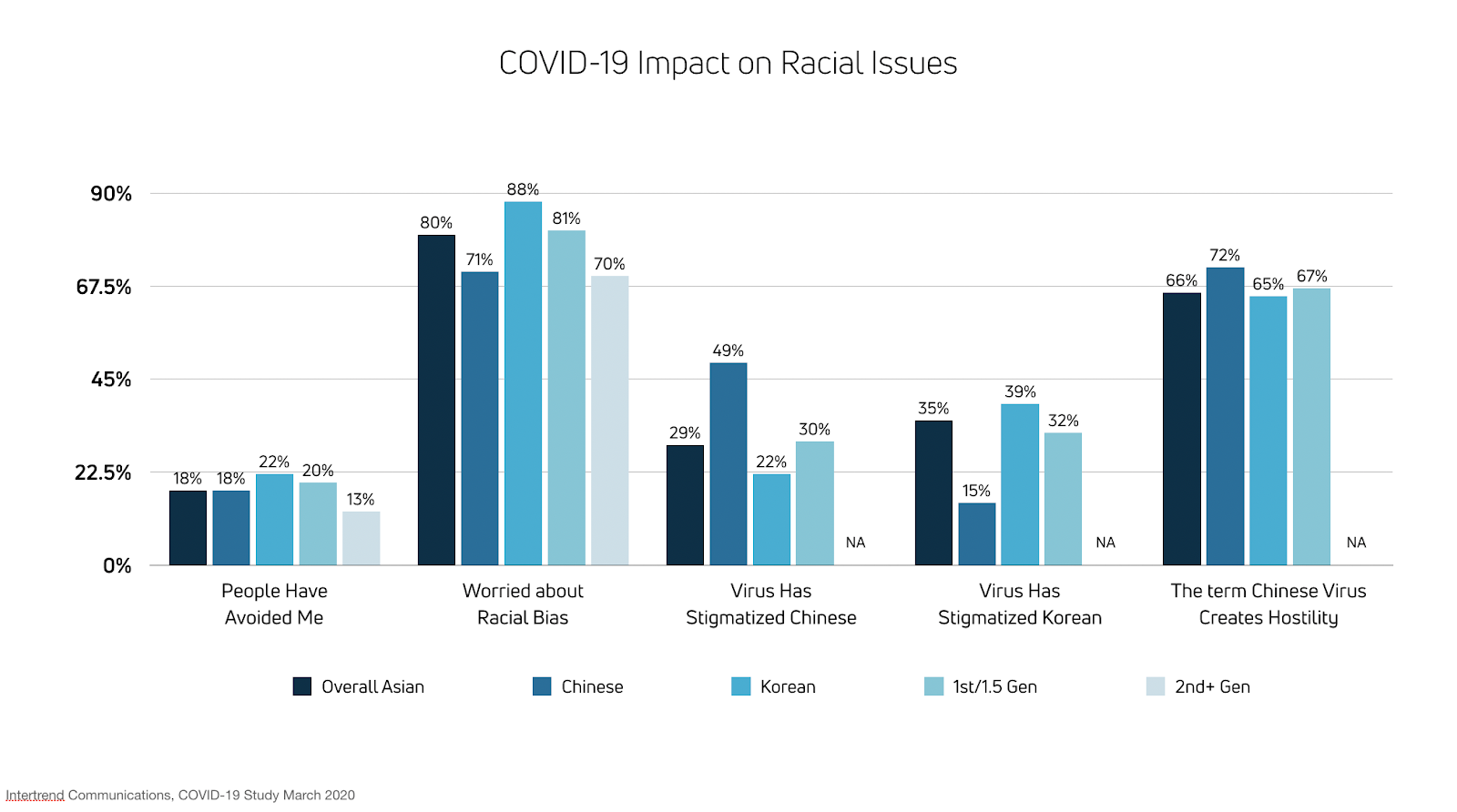
Social media listening analysis demonstrates that the term "China virus" spiked mid-March, with 46% of results having a negative sentiment and 14% having a positive sentiment. Twitter was the primary source for conversation around the label. This timeline matches with Trump's first time calling COVID-19 the "China virus" via a retweet on March 10 and then his television address on March 11 where he referred to it as a "foreign virus".
There needs to be greater governmental and media responsibility in the use of language surrounding COVID-19 as well as media initiative to report on these issues. The decisions being made by publishers regarding what stories to highlight and which voices to amplify are critical in creating an imperative in which all groups can work together to survive this pandemic.
The Ultimate Opportunities
If all stakeholders - governments, health agencies, municipalities, businesses, citizens, and media - make carefully considered judgments with the limited information available to propel people towards taking actions that are best for all, then this course-changing global event can increase kindness and gratitude towards one another, heighten civic responsibility, and promote empathy and collaboration with our Asian allies and Asian American neighbors.
How can the media, with so many eyes constantly watching and reading material, use their resources to generate greater understanding and drive positive action? The media, at this time, consists of traditional print and digital outlets, but includes publishers of all sizes with any audience. Four ways media can make a difference are: positively change perceptions on topics, give back generously, provide balanced localized coverage, and cooperate globally for consistent messaging.
First, the media has the power to dispel myths and vilify bad behavior. Stories that, for example, describe the extensive impact of the virus on Asian American businesses since the initial outbreak in Wuhan in January can change the views of people on the Asian American plight. The recent emergence of stories on the effects of COVID-19 lockdowns have helped promote community support for small businesses, but these stories need to be reported proactively and should have been inclusive of Asian American businesses from the beginning, which were impacted much earlier. The media can educate audiences before misbehavior and misinformation become necessary to address.
Next, the media has the responsibility to give back with their time, talents, and platforms in concrete actions. Currently, consumers want to hear reassuring messages from brands, but what can actually help relieve the overwhelmingly high fears and anxieties discussed above, is for companies to take action for the greater good. Auto manufacturers are retooling their shut down production lines to build medical supplies and fashion brands are using their machinery, labor, and materials to produce face masks. Likewise, the media can use their resources to amplify critical messages that need to be delivered to the public, donate in-kind placements for educational PSA messages, and encourage community involvement with local organizations or in grassroots activism.
There is a manufactured tension between the government and news organizations, perpetuated by both sides. News channels delivering messaging contingent upon political affiliation may downplay the severity of issues such as the lack of PPE or racist attacks on Asian Americans. At this time, the relatively balanced coverage of local media is crucial. Local media is showing commitment to the higher purpose of battling the pandemic with less politicized publishing that prioritizes the health and safety needs of their communities.
As previously highlighted, Asian Americans are reading and trusting international media in-language news and stories. Considering how COVID-19 is a global pandemic, there can be stronger cooperation and consistency in messaging across countries. To accomplish this global communications strategy, health and media leaders can facilitate systems where health agencies provide media outlets with information that bridges science and public narratives. For example, the UN has launched a detailed Open Brief to creatives worldwide asking for help in providing engaging accurate messaging on social distancing, knowing the symptoms, kindness contagion, and more.
Both the media and the Asian American community have the ability to help save lives and show compassion towards one another, whether that is as a mainstream or Asian media publisher taking responsibility for providing critical news, or as a citizen sharing content and stories to influence their communities, or as a consumer supporting a small Asian American-owned business to help it weather economic difficulties, or as a reader choosing to read trustworthy local press. As COVID-19 continues to spread in our communities and conversations, we are agents for making positive change.
About the Study
Intertrend conducted a quantitative study to better understand the role of media and general sentiments during COVID-19 among Asian Americans. Exploration topics included sources of news and media consumption, sentiment about media coverage, attitudes about government health organizations, general perceptions of COVID-19, anxiety/fears about the virus, and economic impact.
The fieldwork was completed in March 14–28, 2020 among 430–450 Chinese, Korean, and other Asian Americans, conducted in English, Chinese, and Korean languages. In addition to the Intertrend team, Beverly Cotter, a research assistant for the Asian American Transnational Research Initiative at Cal Poly Pomona was part of the research collaboration team.
Intertrend also conducted social listening in parallel to the study to assess what topics people have been proactively searching for online. This reporting is based on data generated from Google Trends in the U.S. and in some of the Asian regions, and insights from analysis on Brand24.
About the Authors
Tanya Raukko is the Chief Strategy Officer at Intertrend Communications. Charis Poon is a Creative Strategist at Intertrend as well as a co-host of the podcast Making It Up and a core editorial team member at MAEKAN.